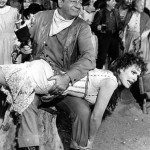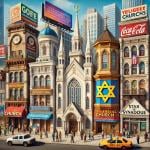In 1990, Jewish Federations released the results of the National Jewish Population Survey with its infamous statistic that intermarriage had hit an all time high:
The 1990 NJPS is best remembered for one number: 52 percent. This was the study’s estimate of the intermarriage rate (counting marriages between 1985 and 1990) for individuals born as Jews. This contrasted sharply with intermarriage rate estimates of 44 percent for marriages between 1975 and 1984, 25 percent for 1965-1974, and 9 percent for those that took place before 1965.
I began my career under the shadow of that “52%” boogeyman. Later the number was revised under pressure from demographer Stephen Cohen to the low forties. In the meantime, fear of a disappearing Jewish community led to the establishment of Jewish “continuity committees” in every corner of Jewish America. It also led to meaningless slogans such as Hillel’s mission “to maximize the number of Jews doing Jewish with other Jews.”
Then in 2000 another survey was released. This time the intermarriage number had been fixed but not the reasons to “shry gevalt.” The community was depicted as a shrinking, graying population of 5.2 million.
Now comes Brandeis University’s new aggregate study with a shiny new number of 6.5 million. That’s a big difference and it should have some impact on how the Jewish community conducts business. The Forward’s J.J. Goldberg points out the political implications:
Impending disaster brings out the conservative in all of us. The institutions of American Judaism have been on emergency footing for decades, through foul weather and fair, because of mounting alarm about vanishing American Jews. That happens to coincide with a period in which the public face of American Jewry has come to be perceived as increasingly conservative. Do the math.
The “public face,” but not necessarily the “Jew in the street.” There we still find that well over two-thirds are essentially progressive. Goldberg goes on to point out that the doomsayers in the previous surveys were just wrong about the numbers. That’s corroborated by the much less well publicized corrections that were regularly issued.
If Jews really aren’t dwindling but in fact increasing, then there’s little need for the fear and defensiveness to which we’ve grown accustomed. The Jewish institutional world can afford to be less guarded, less pessimistic about its future. Donors and budget directors can stop agonizing over communal dollars spent assisting the non-Jewish poor rather than preserving the Jewish identity of our own youngsters. The community can, in short, be more liberal if its own future seems secure.
One last interesting datum from this survey is that almost one million of those who identify Jewishly do not have a Jewish religious identity. These are secular Jews. I am firmly convinced that a large number of the so-called “religiously identifying” Jews are not all that religious. The study shows they rarely attend a synagogue. But that’s a subject for another post.














